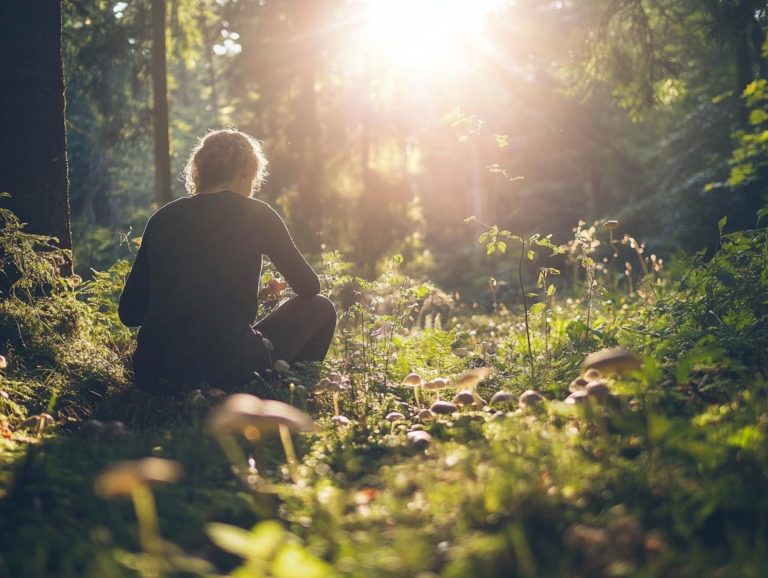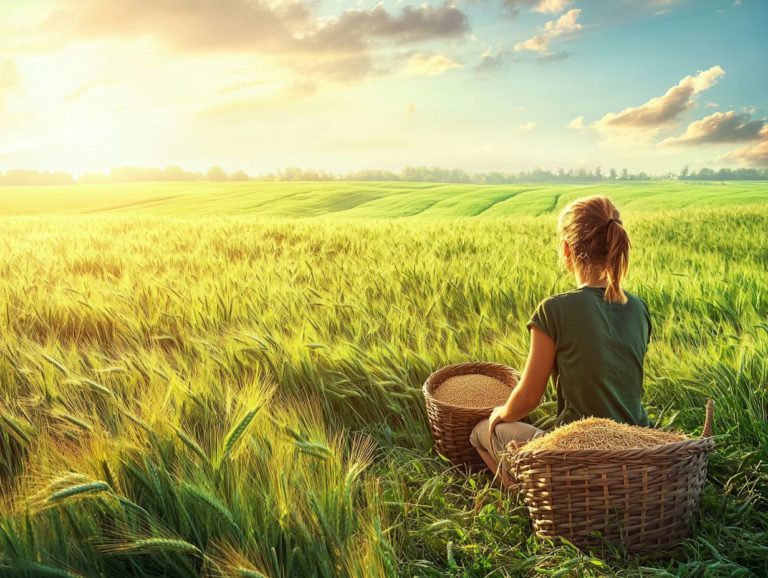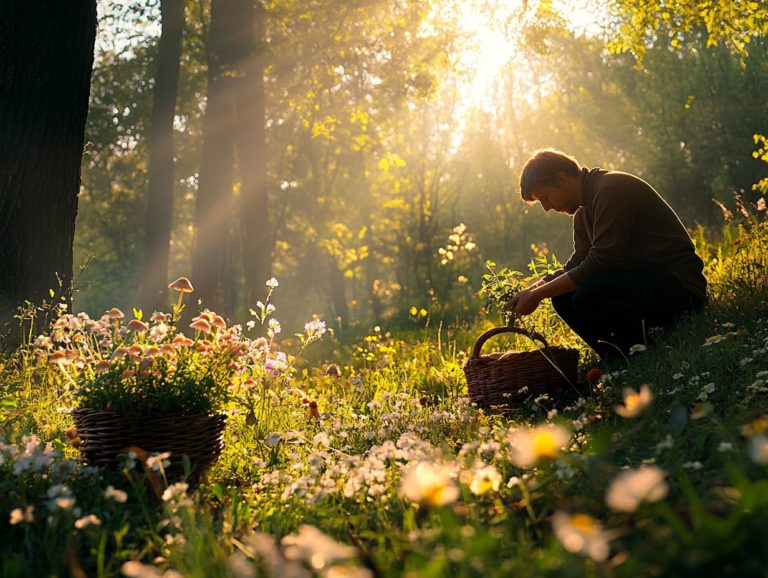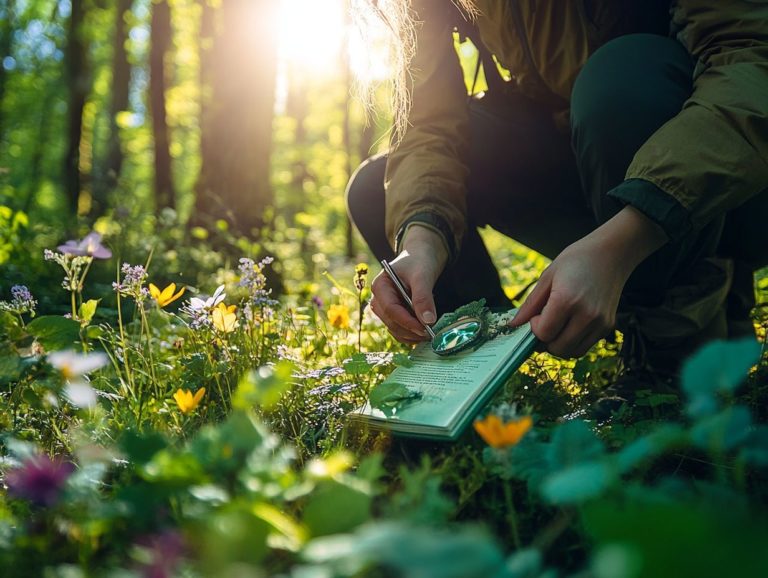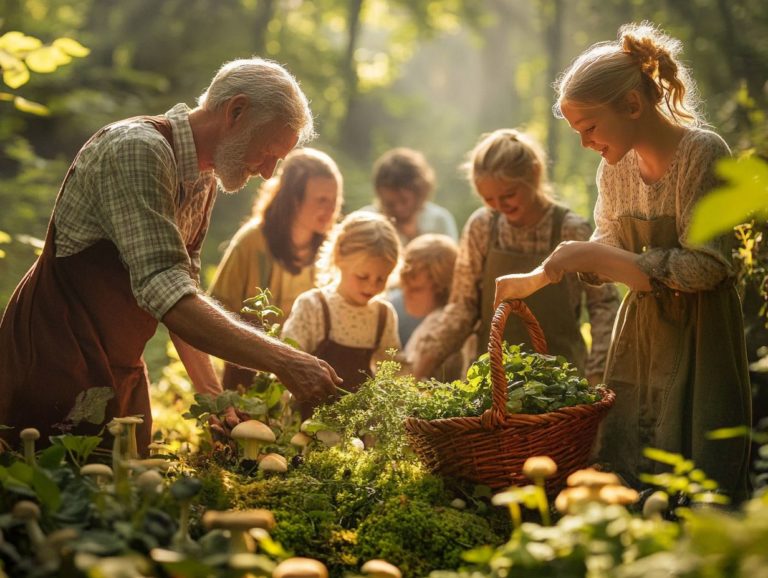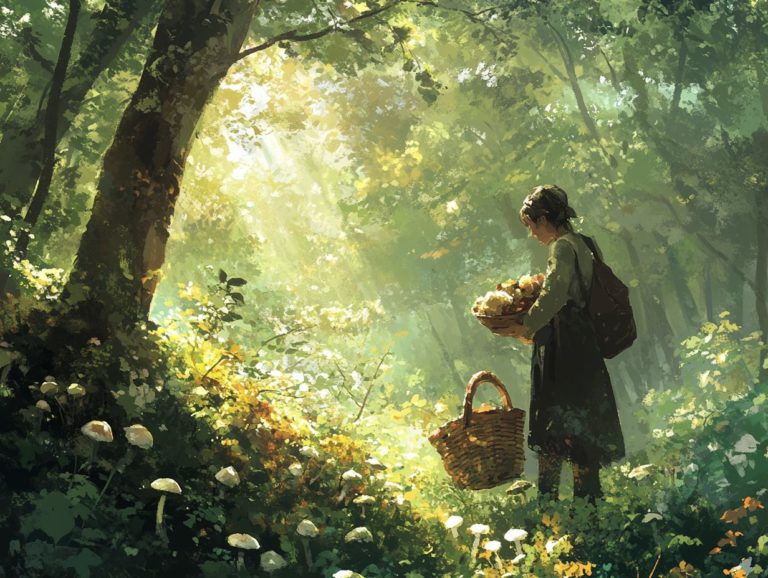Foraging Techniques for Sustainable Eating
Foraging transcends mere trendiness; it invites you on a journey into the natural world, forging a deeper connection with your environment while championing sustainable eating. You ll discover the myriad benefits of foraging, from its positive impact on the ecosystem to the nutritional perks of embracing wild foods.
Essential techniques for identifying and preparing edible plants await you, along with crucial safety tips designed to make your foraging adventures both enjoyable and secure. You ll also discover best practices for preserving natural resources, ensuring that foraging remains a sustainable endeavor for generations to come.
Dive into foraging and unlock the amazing secrets of nature!
Contents
Key Takeaways:
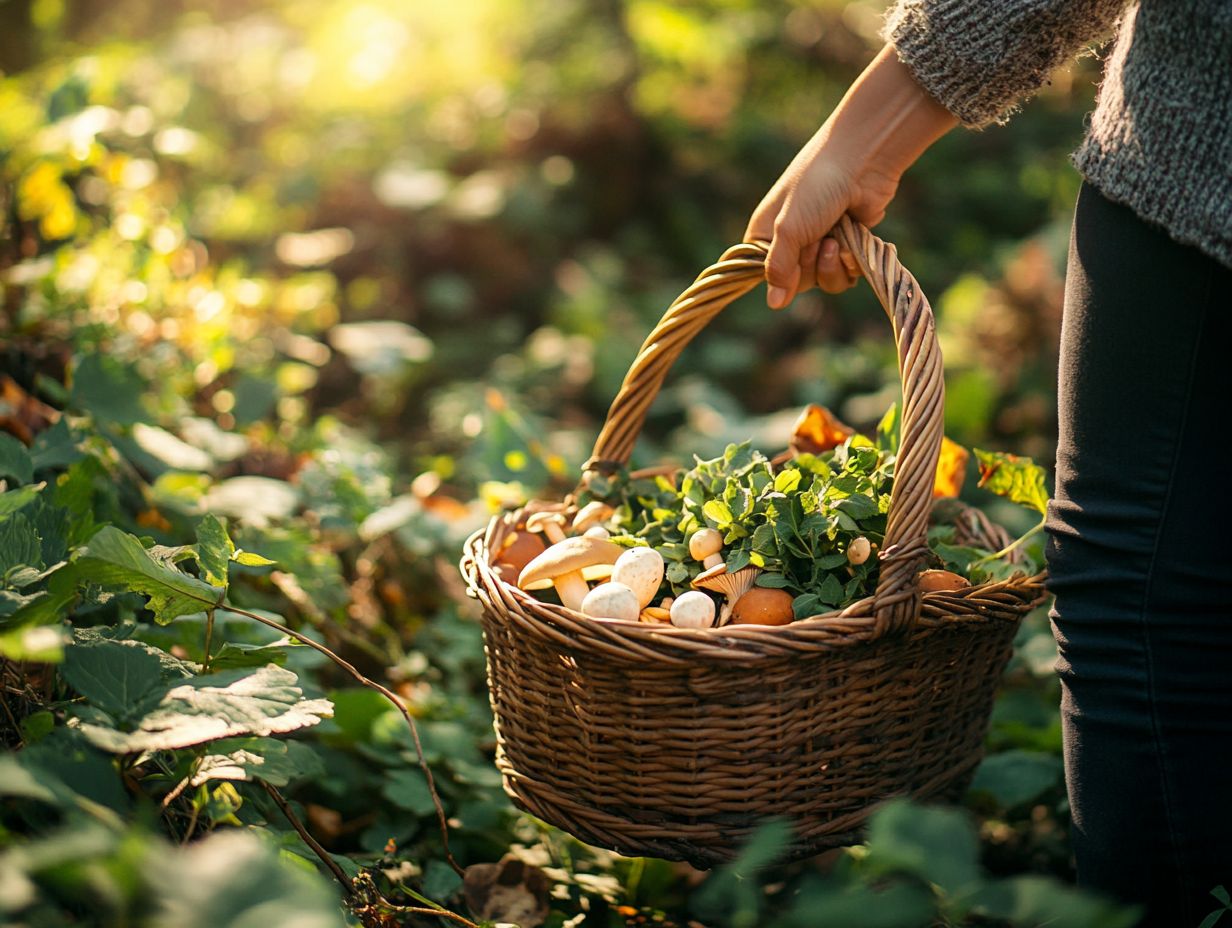
- Foraging gathers food from nature, encouraging sustainable eating and reducing waste.
- It enhances nutritional diversity and reduces environmental impacts.
- Learn identification and harvesting techniques for successful foraging.
Discovering the Art of Foraging
Foraging is the art of seeking and gathering wild food resources, like edible plants, mushrooms, and herbs, found in both rural and urban settings. This ancient practice has experienced a renaissance in today s world, particularly among those who advocate for the right to healthy food produced through ecologically sound and sustainable methods, emphasizing the value of local ingredients. Engaging in foraging allows you to connect deeply with your local ecosystems and indigenous foodways, enabling you to gather your own sustenance.
The origins of foraging can be traced back to ancient cultures, where hunting and gathering were pivotal for survival, reflecting a profound bond with nature. Over time, this practice has evolved, adapting to the availability of resources and the rise of cultivated foods.
Urban foraging, a contemporary spin on this age-old tradition, invites you to discover edible plants hidden within city landscapes, unveiling a wealth of nature amid the concrete.
Notable figures like Alexis Nikole, who advocates for the mindful harvesting of wild edibles, and Karl Holl, a champion of wildcrafting, have underscored the importance of recognizing nature’s bounty even in bustling urban environments. By embracing these principles, you can transform your everyday surroundings into potential food sources, revealing foraging’s cultural significance as not merely a survival skill but also a powerful means to reconnect with nature.
Benefits of Foraging for Sustainable Eating
Foraging presents a wealth of benefits for those committed to sustainable eating. It fosters food sovereignty, enhances food access, and deepens your connection to local ecosystems. By gathering wild edible plants and mushrooms, such as morel mushrooms and wild onions, you not only nourish yourself but also play a vital role in foraging techniques for a sustainable future that honors and respects the environment.
Environmental Impact
The environmental impact of foraging is quite complex, with sustainable foraging practices playing a vital role in promoting biodiversity, preserving local ecosystems, and minimizing the carbon footprint linked to commercial food production. Learning foraging techniques for wilderness survival helps source food locally, allowing you to alleviate the challenges of food deserts and cultivate a healthier relationship with the land.
Engaging in these practices can lead to a richer variety of species and greater stability within habitats, benefiting both plant and animal populations. However, it s important to recognize that unsustainable foraging can bring significant risks, such as overharvesting specific species, disrupting local wildlife, and depleting plant populations.
To steer clear of these negative consequences, you should adhere to guidelines that emphasize:
- Seasonal picking
- Proper identification of plants
- Maintaining respectful distances from critical breeding grounds
By nurturing responsible habits, you not only protect local ecosystems but also contribute to the overall health of our planet s biodiversity.
Start your foraging adventure today and reconnect with the earth in a meaningful way!
Nutritional Benefits
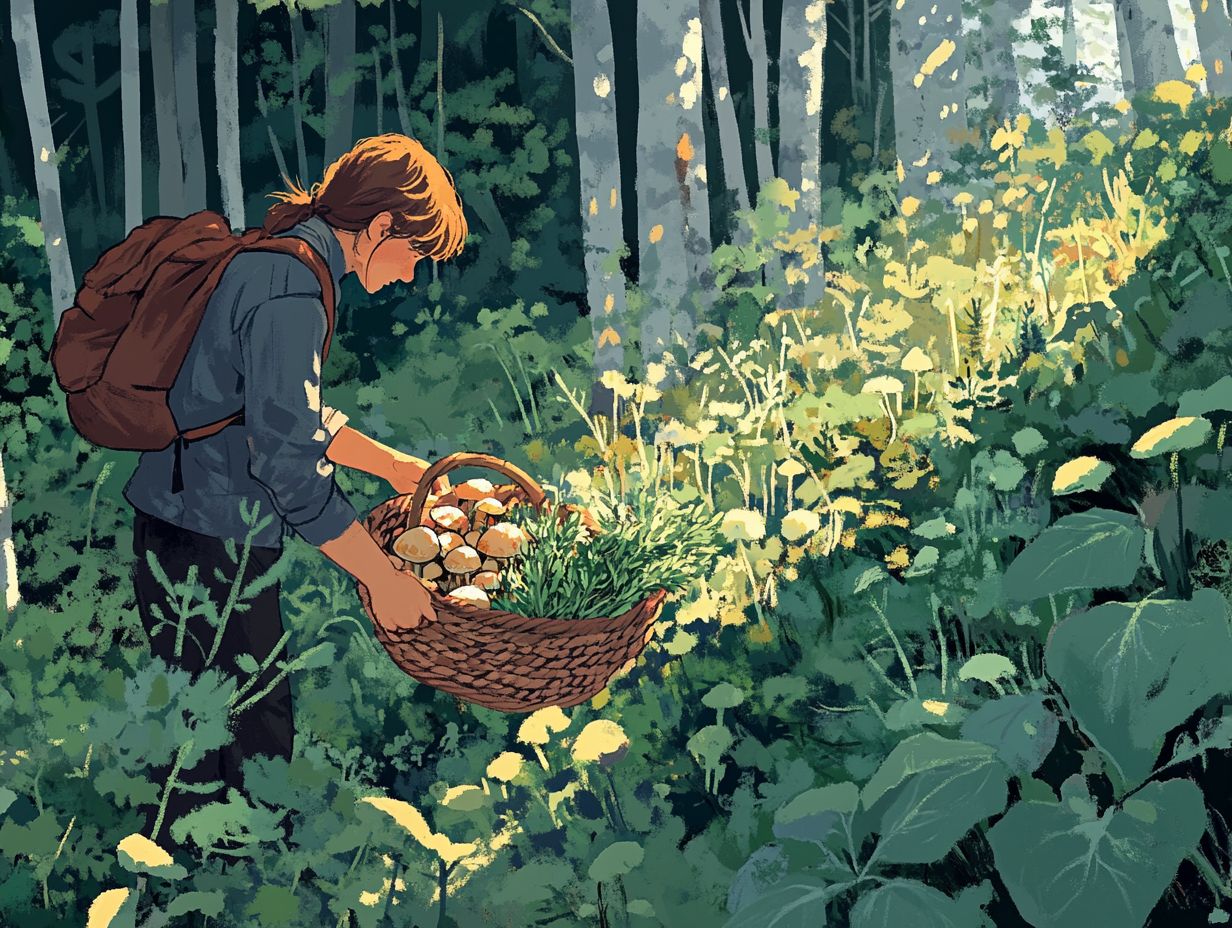
Foraging opens the door to a treasure trove of edible and medicinal plants that often surpass conventionally grown produce in terms of nutrients. By incorporating foraged delights like stinging nettle and dandelion into your diet, you can elevate your nutritional intake while championing food sovereignty.
These wild greens are packed with vitamins A, C, and K and essential minerals like iron and calcium nutrients that are often lacking in supermarket offerings. The unique compounds found in foraged foods, such as antioxidants and flavonoids, provide notable anti-inflammatory benefits that enhance your overall health.
Unlike store-bought produce, which may lose nutrients during transportation and storage, foraged items are consumed fresh. This delivers a vibrant burst of flavors that invigorate your culinary experience. This connection to local environments broadens your palate and promotes a sustainable lifestyle, making foraging an exciting choice for those who prioritize their health.
Basic Foraging Techniques
Basic foraging techniques for sustainable living encompass a variety of skills that help you identify, harvest, and prepare edible plants and mushrooms sustainably.
From recognizing wild onions and blackberries to mastering the best practices for gathering morel mushrooms, these techniques are crucial for ensuring your foraging adventures are both successful and rewarding.
Identifying Edible Plants
Identifying edible plants is an essential skill for you as a forager. It enables you to differentiate between safe and unsafe species in the wild. Familiarity with local flora, including plants like stinging nettle and dandelion, is vital for anyone interested in wildcrafting, which means gathering wild plants for food or medicine.
To refine this crucial skill, consider using field guides tailored to your region. These resources often feature clear illustrations and detailed descriptions that facilitate accurate identification. Investing time in local workshops or joining online communities can also be beneficial, as experienced foragers are eager to share their insights and tips.
While you re out exploring the forest or nearby patches of greenery, stay vigilant about poisonous species like hemlock or foxglove, which can pose serious health risks. Mastering the identification of these common edible plants enhances your foraging adventures and ensures you enjoy safe and nutritious meals in the great outdoors.
Harvesting and Preparing Foraged Foods
Harvesting and preparing foraged foods invites you to blend respect for nature with cooking skills. Ensure that your gathered ingredients are utilized sustainably by following principles outlined in foraging: a sustainable food source for all. You can explore a spectrum of techniques, from crafting simple salads with fresh foraged greens to employing advanced methods that showcase the distinctive flavors of treasures like morel mushrooms and blackberries.
To fully savor the wild’s bounty, it’s essential to adopt best practices, such as only taking what you need and being mindful of the local environments. For instance, using saut ed morels in a creamy risotto can elevate your dish, while fresh blackberries can transform a tart or jam into a delightful masterpiece.
Get creative with preservation techniques like drying or pickling, so you can relish seasonal delights throughout the year. By experimenting with diverse flavor pairings, you can ensure that each ingredient complements and enhances the others, crafting a symphony of tastes that celebrates the gifts of nature.
Foraging Safety
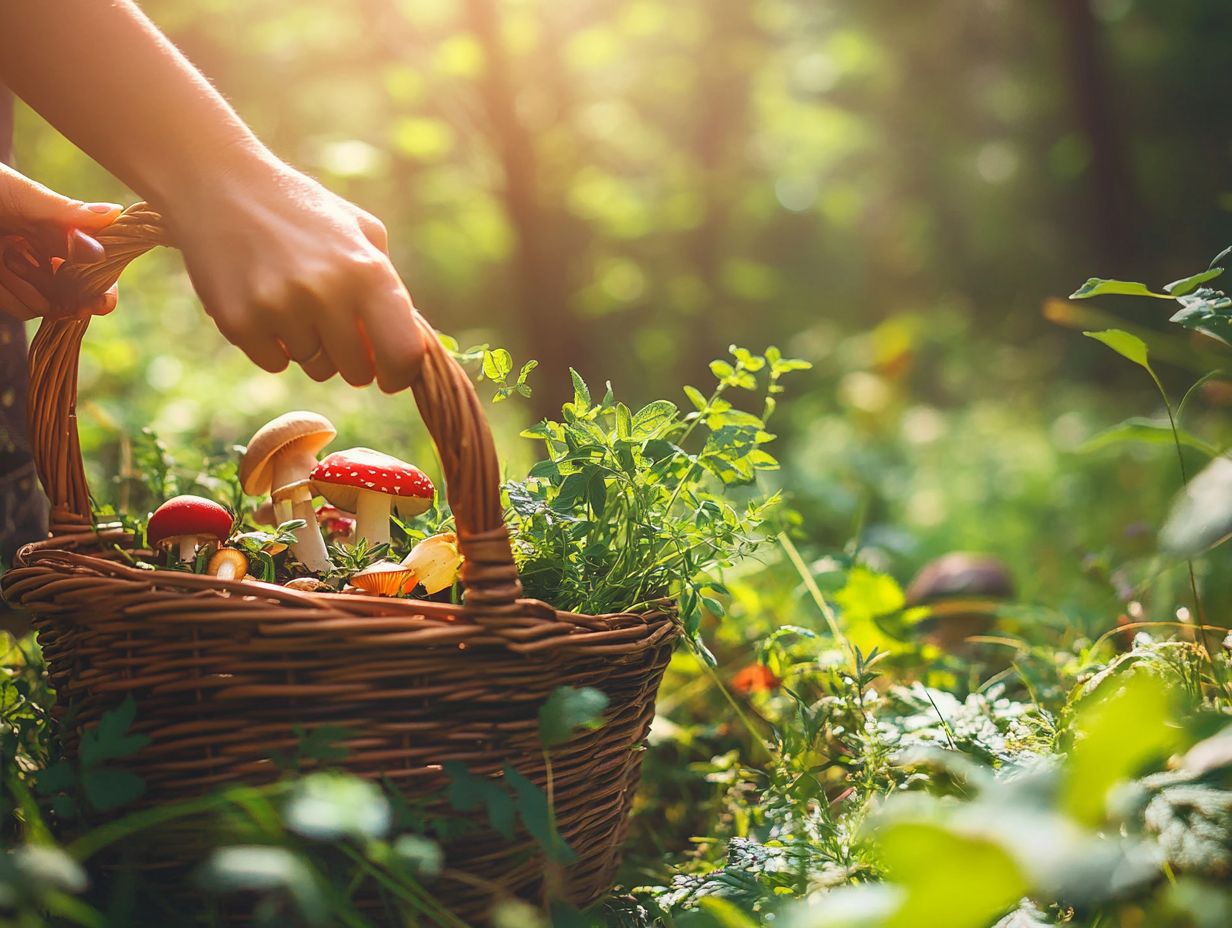
Foraging safety is essential for a successful and enjoyable experience. It requires a keen awareness of potential risks, such as misidentifying poisonous plants or encountering hazardous environments.
By following foraging ethics and best practices, you can navigate the wild responsibly. This contributes to sustainable food systems, and exploring foraging techniques for sustainable gardening can help alleviate food deserts.
Start your foraging adventure today and discover the amazing flavors waiting for you!
Potential Risks and How to Avoid Them
Knowing the risks of foraging is vital for anyone keen on safely gathering wild foods. Misidentifying poisonous plants can lead to serious health concerns. Familiarize yourself with their characteristics and follow foraging ethics to effectively minimize the risks associated with this rewarding endeavor.
Consider the common threat posed by plants like poisonous hemlock or nightshade. These plants can easily be mistaken for safe varieties. It’s imperative to conduct thorough research on them and rely on reliable field guides to sharpen your identification skills.
Engaging with local foraging groups or attending workshops can offer invaluable hands-on experience that enhances your knowledge. Proper preparation also includes pinpointing the specific environments where these plants thrive, such as the moist, shaded areas favored by hemlock.
Adopting ethical foraging practices, like ensuring enough plants remain for regeneration and minimizing disturbance to wildlife, protects the ecosystem. This guarantees that future foragers can relish the abundance nature has to offer.
Best Practices for Sustainable Foraging
Best practices for sustainable foraging center on preserving the resources you gather and minimizing your environmental footprint, such as using foraging techniques in responsible living. This ensures that wild ecosystems thrive for future generations.
Use responsible harvesting techniques. Follow local regulations and embrace the ethics of foraging. By doing so, you contribute to the health and productivity of nature, fostering a harmonious relationship between your foraging endeavors and the environment.
Preserving and Sustaining Foraged Resources
Preserving and sustaining foraged resources is essential for maintaining the delicate balance of ecosystems. This also ensures that future generations can relish the benefits of wild foods. Techniques such as drying, fermenting, and canning not only extend the shelf life of foraged ingredients but also elevate their culinary potential.
By employing these methods, you can craft flavorful jams, pickles, and dried herbs. These not only deliver a nutritional boost but also celebrate the unique flavors of seasonal ingredients. Take fermenting, for example it not only preserves foods but also nurtures beneficial bacteria that help with digestion.
When foraging, it’s crucial to adopt foraging techniques for sustainable practices. Take only what you need and leave enough resources for regrowth to ensure that these natural treasures remain plentiful. Emphasizing such practices deepens your connection with nature and promotes ecological responsibility. This allows you to savor the delights of wild edibles while safeguarding them for the enjoyment of future generations.
Frequently Asked Questions
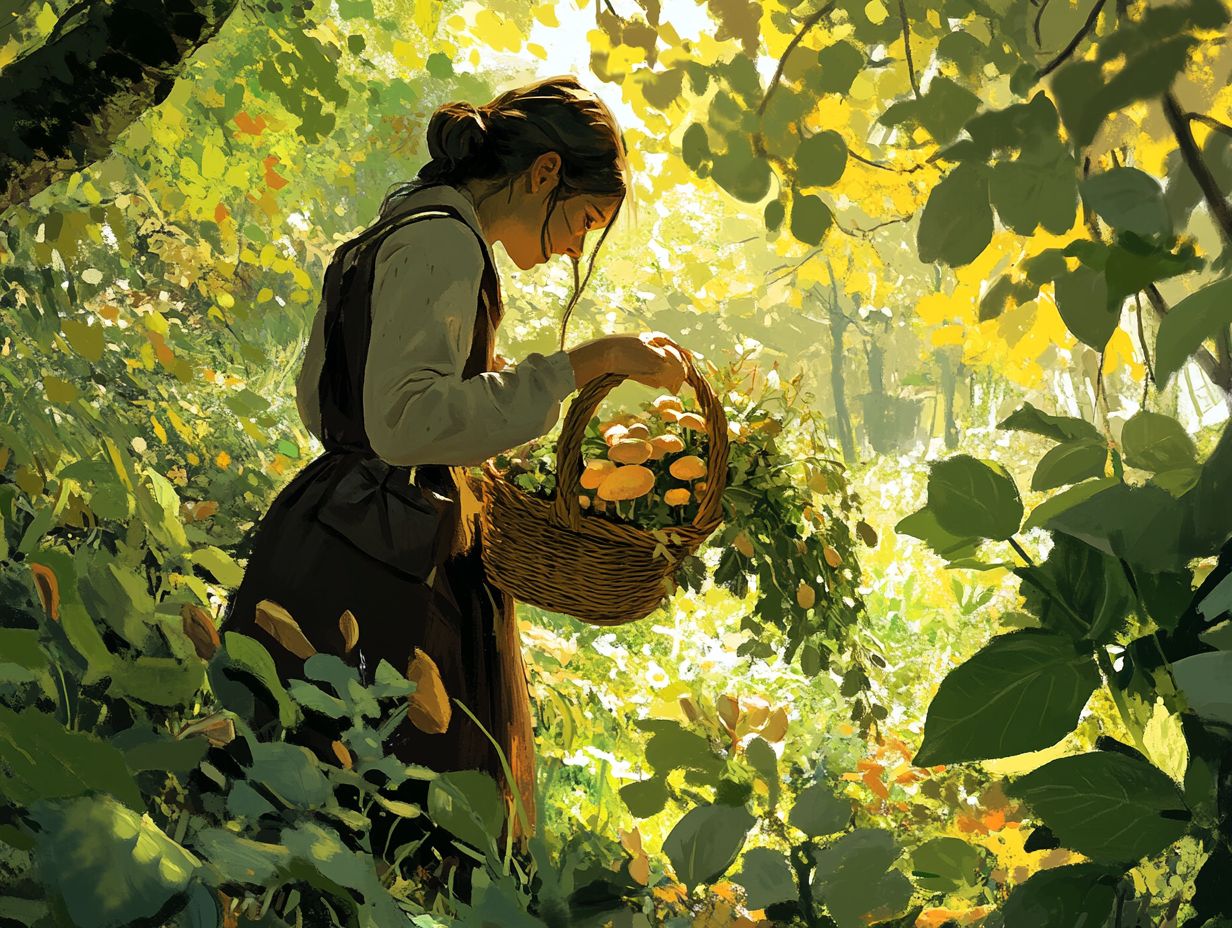
What are foraging techniques?
Foraging techniques refer to the methods used to find and gather food from the wild, such as fruits, nuts, and plants, while also emphasizing protecting nature through sustainable foraging.
Why is foraging important for sustainable eating?
Foraging reduces dependence on industrial farming and supports a natural diet.
What are some common foraging techniques?
Common foraging techniques include identifying edible plants and using tools like knives or baskets to gather food. Understanding the role of foraging techniques in sustainability and learning to recognize different habitats is also important.
How can I ensure that foraging is sustainable?
To ensure sustainable foraging, gather only what you need and leave enough for the plant or organism to continue growing and reproducing.
Are there any safety precautions I should take when foraging?
Yes, always properly identify the plants and mushrooms you are foraging before consuming them to avoid any potential dangers or allergic reactions.
Can foraging be done in urban areas?
Yes, foraging can also be done in urban areas by identifying edible plants and fruits in parks, gardens, and even along sidewalks.

